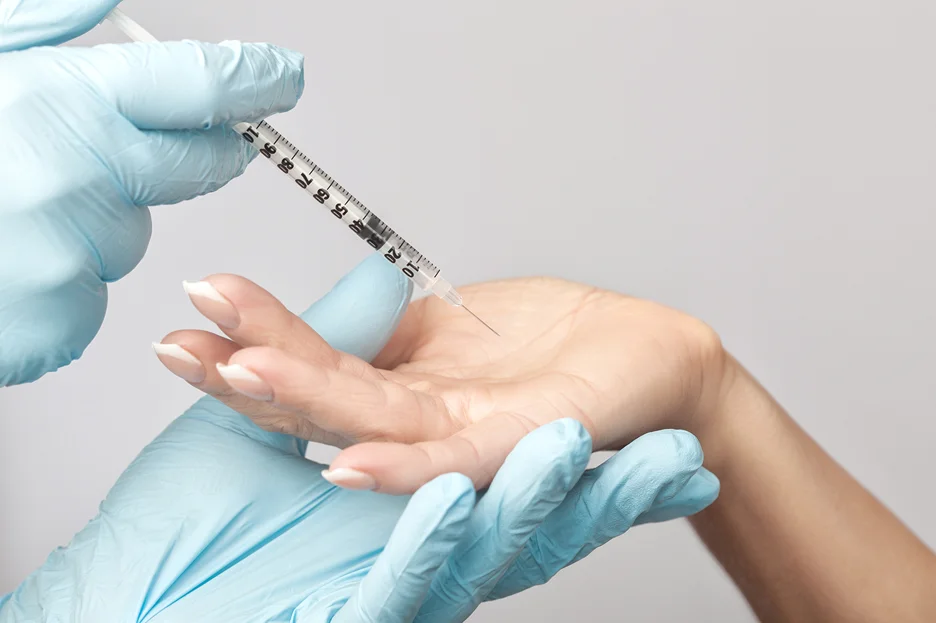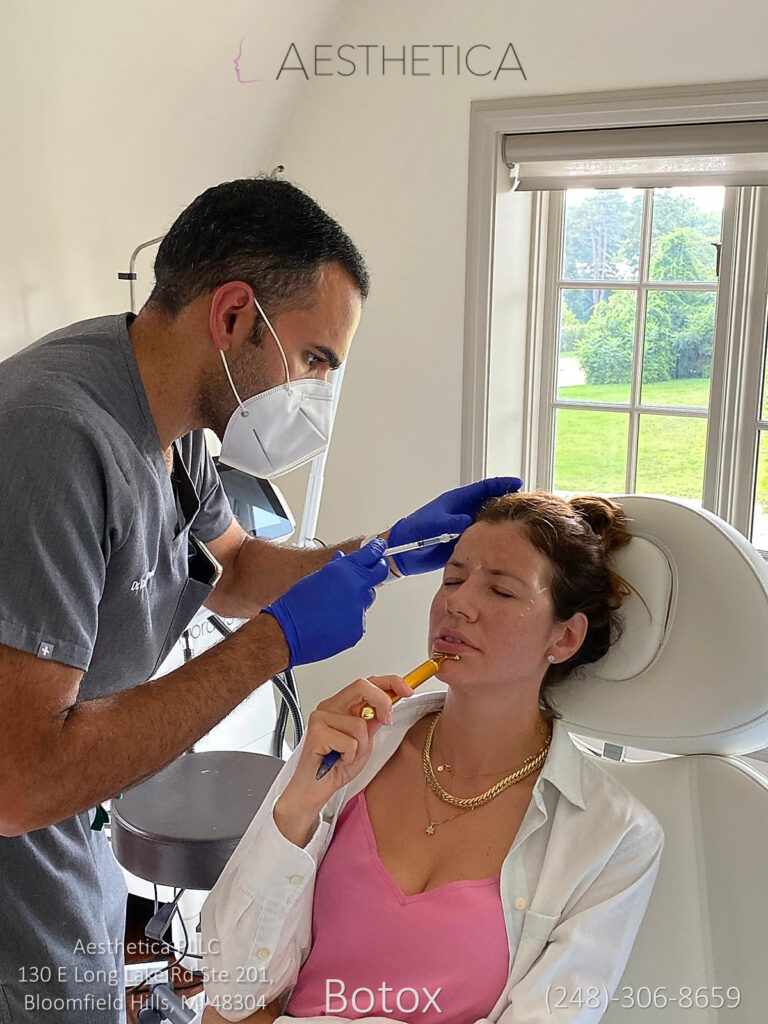
While sweating is natural when you're feeling hot or under stress, your body can sweat more than it should, often for no apparent reason – and this is most likely a condition called hyperhidrosis. It can be unpleasant and embarrassing, so some avoid seeking help to hide their sweating problem. While over-the-counter or prescription antiperspirants can help, a Botox injection for excessive underarm sweating is also a good option.
So how does Botox help hyperhidrosis? Botox is a protein made by the Clostridium botulinum bacteria. Small doses of an injectable form of the botulinum toxin limit the release of the chemical messenger acetylcholine, temporarily blocking the nerves in the underarm that induce sweating, which is known medically as primary axillary hyperhidrosis.
Aesthetica can assist you with all your beauty needs, helping you achieve your maximum beauty and aesthetic potential. Call or contact us today to learn more about our cosmetic services.
OnabotulinumtoxinA is a pure natural protein that can temporarily prevent the secretion of the chemical that causes the body's sweat glands to "switch on." Botulinum toxin "turns off" sweating in the area where it has been injected by inhibiting, or interrupting, this chemical messenger. Botox injections are very shallow, which means the medicine is administered just beneath the skin's surface and stays there.
Botulinum toxin and botulinum toxin A treatment for hyperhidrosis have been demonstrated to reduce perspiration by 82 to 87% when used to treat excessive sweating in the underarm area. The results begin to show up 2 to 4 days after treatment, with the maximum effects usually appearing around 2 weeks. Dryness lasts 4 to 12 months on average, but some studies show it can last up to 14 months.
Botox (onabotulinumtoxinA) was approved by the United States Food and Drug Administration (FDA) in 2004 for the treatment of severe primary axillary hyperhidrosis (excessive sweating of the underarms) in individuals who couldn't get relief from antiperspirants.
Botox is the most studied brand of botulinum toxin in the world, produced by Allergan, Inc. of Irvine, California. Botox was first approved by the FDA in 1989 and is now approved to treat a total of eight medical disorders in the United States. Millions of individuals have benefitted from it throughout the years, including those suffering from spasticity and movement abnormalities.
A very fine needle is used to inject tiny doses of Botox just beneath the skin, intermittently across the area of excessive sweating, during the operation (in a grid pattern, approximately every 1 to 2 cm) Your dermatologist will determine how many injections you need based on the size of the area to be treated. Anesthetic treatments such as nerve blocks, cold, and vibration analgesia may be used by doctors to alleviate any potential discomfort.
When hyperhidrosis is limited to a single location of the body, Botox injections work best. Botox is not recommended for pregnant or breastfeeding women, or for anyone with a history of neuromuscular issues, according to experts. Because Botox can induce muscle weakness in the hands, dermatologists like Fiessinger will consult with patients to evaluate whether Botox is the best option for them.
It’s overall an easy process – up to an hour before the injections, numbing cream is administered to the treatment region. The doctor will clean the afflicted area and administer a series of injections using a very little needle. After the procedure, there may be some bruising, swelling, or discomfort, but it should be mild. In most cases, patients observe effects after 5 days, with complete outcomes appearing after 2 weeks.
An antiperspirant containing aluminum chloride may be prescribed by your doctor (Drysol, Xerac Ac). It is possible that this product can irritate your skin and eyes. Before going to bed, it's frequently applied to the affected area. When you wake up, wash the product off and be careful not to get it in your eyes. Hydrocortisone cream may be useful if your skin becomes inflamed.
Hyperhidrosis affecting the face and head may benefit from a prescription cream containing glycopyrrolate. Just make sure to go to a reliable provider to get the best brand of prescription cream for your sweating problems.
Some oral drugs prevent particular nerves from communicating with one another by blocking the molecules that allow them to communicate. Some people may find that this reduces their sweating. Dry mouth, blurry vision, and bladder issues are all potential side effects.
Sweating can be reduced by several drugs used to treat depression. They may also aid in the reduction of anxiety, which aggravates hyperhidrosis. But it’s important to note that this isn’t advisable for those who aren’t clinically diagnosed with any psychological disorder, as these can alter your brain chemistry. It’s better to opt for the above treatments if so.
In this treatment, sweat glands are destroyed using a device that emits microwave energy. Two 20- to 30-minute sessions are scheduled three months apart as part of the treatment plan. Changes in skin feeling and pain are two potential adverse effects. It's possible that this treatment will be costly and difficult to obtain.
Taking out the sweat glands in your armpits may assist if you have excessive sweating there. If you aren't responding to other therapies, a minimally invasive procedure called suction curettage may be a possibility.
The spinal nerves that govern perspiration in the hands are severed, burned, or clamped during this surgery. This technique can cause excessive sweating in other parts of the body in some people (compensatory sweating). For isolated head and neck sweating, surgery is typically not a possibility. The nerve signals are disrupted without the sympathetic nerve being removed in a version of this treatment sympathectomy.

Aluminum-based components in nonprescription antiperspirants temporarily block the sweat pore. The amount of sweat that reaches your skin is reduced as a result of this. Minor hyperhidrosis may benefit from this type of product.
You can apply tannic acid or Zilactin-containing over-the-counter medicines to the affected region. But be extra careful especially if you have allergies to certain medications – get the go-signal of your doctor first before trying.
Bathing on a regular basis might help reduce the number of microorganisms on your skin. Dry thoroughly, paying specific attention to the areas between your toes and beneath your arms. Consider yoga, meditation, and biofeedback as relaxing strategies. These can assist you in learning to control the stress that causes you to sweat.
Natural-fiber shoes and socks are a good choice. Natural materials, such as leather, allow your feet to breathe, which helps to prevent sweaty feet. Moisture-wicking athletic socks are a good choice while you're active.
Choose attire that is appropriate for your activities. Wear natural fibers that help your skin breathe, such as cotton, wool, and silk. When exercising, you may want to wear textiles that drain moisture away from your skin.
Socks should be changed frequently. Once or twice a day, change your socks or hose and completely dry your feet. You might try wearing pantyhose with cotton soles. To assist in absorbing sweat, use over-the-counter foot powders.
When possible, go barefoot or at least take off your shoes every now and then, especially if you’re wearing enclosed shoes at the time – if it’s a work requirement or if the environment you’re in necessitates it.

Botox injections – especially the botulinum toxin in them – are used for more than just cosmetic surgery, aesthetic purposes, or acne treatment. At Aesthetica, we are masters of Botox helping with problems especially axillary hyperhidrosis, or any other medical condition that involves uncontrollable sweat production.
We’re equipped with all the needed methods and technologies against severe underarm sweating, and our highly-trained team is committed to helping you overcome excessive sweat issues. Let Aesthetica can help you feel and look your best by treating overactive sweat glands. Call us now for a quotation on our procedures using botulinum toxin or book an appointment for your first hyperhidrosis treatment.
Aesthetica can assist you with all your beauty needs, helping you achieve your maximum beauty and aesthetic potential. Call or contact us today to learn more about our cosmetic services.